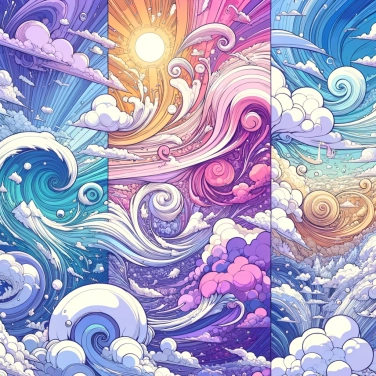The ice crystals present in the atmosphere act as prisms, refracting the moonlight and forming bright halos around it.

For a lunar halo to form, small ice crystals must first be suspended in the atmosphere. These crystals appear up there, at an altitude of about 5 to 10 km, when the air becomes cold and humid enough. Often present in thin clouds like the famous cirrostratus or cirrus, these crystals typically form from water vapor that solidifies without going through the liquid state. And the shape of these small crystals is super important: most of the time, they are small hexagonal crystals in the form of columns or plates with six faces. Yes, like mini symmetrical jewels. These specific shapes play a crucial role for what comes next, because it is thanks to their very regular geometric structures that light will be refracted and give rise to lunar halos.
The light of the Moon is a reflected light from the Sun, so it is never very powerful. But when this soft brightness meets the small ice crystals at high altitudes, something beautiful happens. These crystals are often in the shape of an hexagon, like tiny perfectly shaped pencil pieces, floating in the fine, cold clouds (the famous cirrus clouds). When a beam of light passes through these crystals, it is deflected: this is called refraction. Other times, the light simply bounces off the surface of the crystal, and there, it is reflection. With all these little deviations and reflections combined, the light loses its original path and scatters, creating a distinct glowing ring all around our moon. That’s how a simple moonbeam and tiny ice crystals spontaneously create this poetic halo that catches our eye.
When light passes through ice crystals, it changes speed and slightly bends: that is refraction. It first enters one face of the crystal and then exits through another, somewhat like a ray passing through a tiny icy prism. Each color that makes up the light "bends" at a slightly different angle — this is called light dispersion. As a result, the colors separate a little, and a subtle halo forms with sometimes iridescent hues, distinct or slightly blurred depending on the conditions. This interaction between light and crystals is precisely responsible for the luminous and colorful formation of lunar halos.
To see a lunar halo, the atmosphere must first contain ice crystals, often in high clouds called cirrostratus. These crystals mainly form at high altitudes, where it is quite cold (generally below -20°C to -30°C). In short, the higher and thinner the clouds, the better your chances of seeing this phenomenon. If the air is too humid, the crystals may clump together into large flakes, and goodbye halo. But when they remain small and well-separated, that's perfect. A relatively clear sky around the moon also helps a lot, because halos stand out much better without too many low clouds or fog that spoil the view.
The most common type of lunar halo is the famous 22-degree halo. It resembles a whitish luminous ring located 22 degrees around the Moon, quite sharp and vivid. Another phenomenon observed regularly is the moon dogs, bright points located horizontally to the left and right of the Moon, at the same height. Less frequently seen, the 46-degree halos form a larger circle, but are so diffuse and pale that they generally go unnoticed. Another curiosity is the lunar light pillar, a sort of vertical column stretching above and below the Moon. All these halos appear depending on the orientation of ice crystals in the cold air and how they refract lunar light.
A typical lunar halo usually has an angular radius of about 22 degrees around the moon. This specific figure is due to the particular light refraction caused by hexagonal ice crystals.
The phenomenon of halos is not exclusive to the moon. The sun can also produce luminous halos with the same characteristics, visible when the conditions for the formation of atmospheric ice crystals are met.
Each ice crystal acts like a tiny prism. It is the characteristic hexagonal shape of the crystals that explains why halos typically have a fixed and spectacular diameter when they appear.
The halo can sometimes be accompanied by secondary optical phenomena, such as tangential arcs or 'sundogs' (also known as parhelia), a similar phenomenon observable around the Sun during the day.
A lunar halo is caused by high-altitude ice crystals that refract light, whereas a lunar corona is due to the diffraction of light by fine water droplets present in lower clouds. Coronæ are generally smaller, more colorful, and closer to the moon than halos.
The halos appear in a circular shape because the ice crystals have a random orientation and refract the moonlight at a constant angle around the moon, thereby generating a regular bright circle at approximately 22 degrees in radius.
Yes, even though lunar halos often appear whitish due to the low light intensity, it is possible to distinguish pale colors such as red inside the circle and bluish shades outside due to the phenomenon of chromatic dispersion.
Yes, theoretically, lunar halos can appear in any season as long as high-altitude clouds containing hexagonal ice crystals are present in the atmosphere. However, in winter and autumn, these conditions are more common, making them easier to observe.
Yes, a lunar halo often appears when ice crystals in high-altitude clouds indicate the impending arrival of an atmospheric disturbance, such as a storm or a deterioration in weather conditions.

No one has answered this quiz yet, be the first!' :-)
Question 1/6